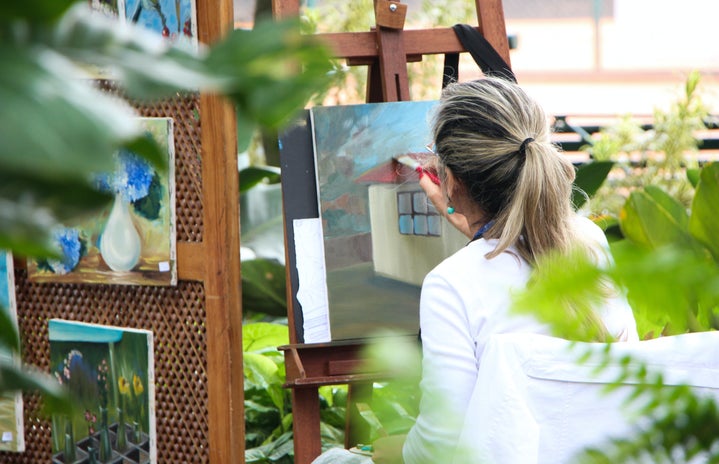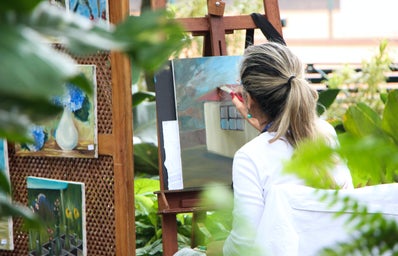Remember that kid in elementary school who started every morning by cleaning out their desk? That was me. I had five different pencil cases, each with its own purpose. I had a different pen for each subject and proudly flaunted my “pen license”— something that was only awarded to people with nice handwriting. All through my school career, I was the one to create color-coded Google Docs complete with links to relevant articles. My handwritten notes had to be neatly categorized and if my white-out smudged, that was the end. The page would be ripped out and another half-hour was spent rewriting the notes. I was the kid who did homework on the night that it was assigned and asked the teacher for more. As much as I deny it, I was the teacher’s pet. It seems counterintuitive that I’d end up an art major.
Courtesy of Ashleigh Penrod
In sixth grade, we took a personality quiz, a Buzzfeed quiz of sorts, to figure out which side of our brain was dominant. The gist of it was that if one side of your brain was dominant, that meant you think more logically, and if the other side was dominant, you think more “creatively.” Perhaps because I was labeled a logical thinker, I lived the rest of my life thinking I could only learn a certain way and I could only do subjects with a very linear nature. Creativity was never a strong suit for me.
In high school, the International Baccalaureate program didn’t provide much wiggle room for us to choose subjects that we enjoyed. Biology and literature were my primary concerns in my junior and senior years. Solving math problems became something I looked forward to doing as a break from Bio. Despite my supposed “passion” for academics, I was always involved in the arts. Dance was something I was committed to since sixth grade and yearbook became part of my life in seventh grade. These two things became the most important aspects of my high school career. However, I didn’t believe that I’d pursue something in the arts past high school. Even during the application process for university, I was in such a state of denial that I was applying to communications and media studies programs. It wasn’t until orientation that it hit me. We were touring Meserve Hall and as I was taking in all the lab spaces and club posters, I suddenly realized neat notes and color coding was no longer going to be part of my life, or at least not such a big part of my life.
Fast forward to second semester of freshman year at college: my schedule is packed with three design classes and a few electives. I never thought design would be easy, but I didn’t think it would be as time consuming and demanding. Remember when I said I did all my homework when it was assigned? That’s no longer possible. One assignment consists of four drafts of something printed three different ways on top of three sketches of obscure items. It’s obvious this can’t be completed in one night. My dedicated work ethic felt unexercised because I wasn’t able to tick off an assignment from my never-ending list. While I was already involved in “creative” subject matter, my brain still thinks in a “logical” way. When I tackle assignments for class, I still have to map out exactly what my process is going to be and what the final product will look like. Putting a time restraint on this kind of project forced me to have a structure to how I create designs. It’s hard for me not to think of homework in the mindset that I just have to complete it for the class. Now, our homework is more about improving our final product than it is about getting the work done. There’s no point in doing work if it’s sloppy and no effort is put into it. I have to climb out of the trance of mindlessly taking notes (no matter how colorful they are).
The nature of the work isn’t the only thing that’s proven to be difficult for my left-dominant brain. Not only do I supposedly think more logically, OCD runs in all the women in my family. One fine morning at 8am, I was sitting quietly awaiting my professor’s crazy demands for the class. I suddenly noticed that the tables in the room weren’t aligned and the corners of the table were jutting out in an angle. As much as I tried to concentrate on the tutorial of how to draw a solid, white cube, I couldn’t focus because the uneven tables were driving me insane. I even tried to adjust the table, but they wouldn’t budge. I suddenly realized my career as an artist was going to be an uphill battle of trying to ignore the unevenness of creativity.
While I’ve already faced struggles I never thought I’d have, I know this is only the beginning. Already, I can tell my brain functions differently and creativity is becoming second nature to me. I still have trouble admitting I’m “artsy,” but I know I’ll get there someday.

